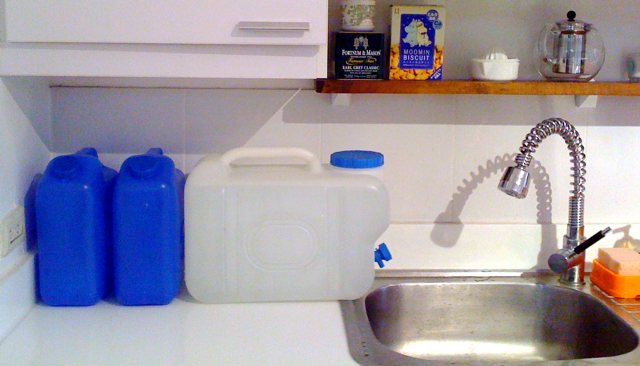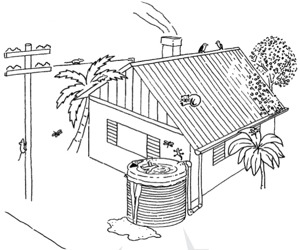Water is always at the top of any disaster preparedness list as it's essential for survival. The generally accepted guideline is to set side
4 liters (1 gallon) of water per person, per day, for drinking and sanitation. Keep in mind that in a tropical country like the Philippines, even the slightest physical exertion is going to leave you dripping with perspiration, thereby causing your body to lose valuable water reserves.
While water storage options are readily available, the biggest problem is that they tend to be bulky and need cycling to prevent a build up of harmful bacteria. This can be especially problematic in condo units where space is a premium. Being a condo dweller in Metro Manila with a wife and water-intensive baby, I know first-hand how difficult this can be.
The solution I've found is to keep water caches in locations where they have practical every-day use. For example, a plastic jerry can with tap kept by the kitchen sink acts as water storage. Once in a while, we use it for washing dishes before topping up the jerry can with fresh tap water.

The clear plastic jerry can in the picture above holds 20 liters, which is enough to last one person for around 5 days. The blue plastic jerry cans hold just over 6 liters each. These can be purchased from hardware stores like Ace Hardware and True Value. (The 20 liter can was approximately Php300 and the blue 6 liter cans are Php49.)
We also keep additional jerry cans in a cupboard and bottled mineral water in the fridge and pantry, as well as a
balde (water bucket) in the shower. In total, I estimate that my wife, baby and I can go almost two weeks just using the stored water in our one-bedroom condo unit.
Note: be sure to store as much of your water as possible at floor level. If stored high up, such as on shelving, movement during an earthquake could cause them to fall. This not only risks injuring someone but also means you lose some of your water reserves. Continue Reading


 The clear plastic jerry can in the picture above holds 20 liters, which is enough to last one person for around 5 days. The blue plastic jerry cans hold just over 6 liters each. These can be purchased from hardware stores like Ace Hardware and True Value. (The 20 liter can was approximately Php300 and the blue 6 liter cans are Php49.)
We also keep additional jerry cans in a cupboard and bottled mineral water in the fridge and pantry, as well as a balde (water bucket) in the shower. In total, I estimate that my wife, baby and I can go almost two weeks just using the stored water in our one-bedroom condo unit.
The clear plastic jerry can in the picture above holds 20 liters, which is enough to last one person for around 5 days. The blue plastic jerry cans hold just over 6 liters each. These can be purchased from hardware stores like Ace Hardware and True Value. (The 20 liter can was approximately Php300 and the blue 6 liter cans are Php49.)
We also keep additional jerry cans in a cupboard and bottled mineral water in the fridge and pantry, as well as a balde (water bucket) in the shower. In total, I estimate that my wife, baby and I can go almost two weeks just using the stored water in our one-bedroom condo unit.